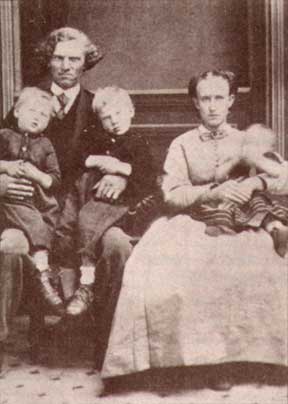 |
| Samuel Walters and his wife Naomi Oliver, with three of their eleven children in 1871 (photo courtesy Gertrude Walters Pearson) |
History in the News
A Century—Cedar Mill
This is an excerpt from a memoir written by the granddaughter of Cedar Mill's first settler. I found a copy tucked into a Cedar Mill History book that I purchased at Powell’s. The original is in the archives of the Washington County Historical Society, which has given us permission to print it. It was probably written around 1950, so many of the places it refers to no longer exist. —VB
Part one: Cedar Mill’s first settler, Samuel Walters
To the people of Cedar Mill, old and new, we hope you enjoy this story of the history of the area and a look at the past.
Samuel Walters, my grandfather, probably the first settler in Cedar Mill, was a farmer at heart and sought fertile land for farming. On his arrival in Portland after coming from Pennsylvania by covered wagon, he was urged by H. King of King’s Heights and other early Portlanders to settle near the river where there would be a growing metropolitan community, but he preferred to cross “the mountain” to the valley where he could farm.
After reports reached the area of the Gold Rush in California, Samuel started on foot with a wheelbarrow and light provisions for that country. He joined other travelers on the way.
On his return, in 1848, he stopped to file a Donation Land Claim for a quarter section of land whereon he settled and planted two waxen apple trees he had carried from California. One of the trees still stands on the Sam Walters property nearly across from the site of the Wolfers barn (near the corner of 107th and Leahy Road). It can be seen in full bloom early in the spring and with a heavy crop of apples in late summer.
Before Grandfather could start farming, many hours of arduous work were necessary to clear trees, since the land was heavily forested with stands of fir and cedar trees. Cedar was most prevalent along the creeks and fir predominant elsewhere. A method of boring and burning was used to fall the trees. The trunk was bored, chips inserted and lighted to burn the trunk across. Immediately upon clearing the timber, timothy (hay) seed was planted in the fertile soil. Reapers were used, followed by threshing with a gangway using horses.
Wild animals were prevalent—deer, bear, cougar and beaver. Beavers were especially busy along Mill Creek (now Cedar Mill Creek). The lower levels of ground were later farmed as highly fertile beaverdam land.
The first home was small, later taking on larger proportions as other early settlers arrived and were given haven until they could make their own homes. Grandfather is said to have remarked that his nearest neighbors were the Walker family on Walker Road. Early residents tell of Indians picking wild blackberries and huckleberries and occasionally coming to doors to ask for food. None lived in this area, but many were settled at Gales Creek.
Next month: The mill and early transportation
|
